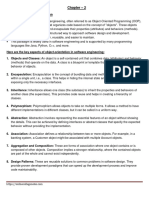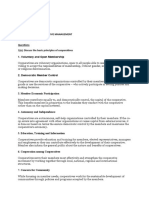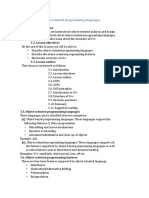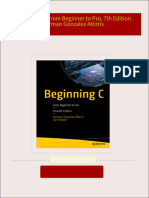Lesson 2: Object Oriented Analysis and Design
Uploaded by
Zak RyderLesson 2: Object Oriented Analysis and Design
Uploaded by
Zak RyderLesson 2: Object oriented analysis and design
2.1. Introduction
In this lesson, you will learn about object oriented analysis and design.
2.2. Lesson objectives
By the end of this lesson, you will be able to
2.3. Lesson outline
This lesson is structured as follows:
2.1. Introduction
2.2. Lesson objectives
2.3. Lesson outline
2.4. Object oriented analysis and design concepts
2.5. Object oriented analysis
2.6. Object oriented Design
2.7. Object oriented implementation
2.8. Revision questions
2.9. Summary
2.10. Suggested reading
2.3. Object oriented and analysis concepts
[a]. Object oriented analysis and design: This is a system analysis and
design methodology which supports bottom-up and top-down
approaches (functional decompositions).Can also be defined as a
software engineering approach that models a system as a group of
interacting objects.
[b]. Object oriented analysis: This is a method of analysis in which
system requirements are identified in terms of objects and their
interactions.
[c]. Object oriented design: A method of realizing system
requirements in terms of classes, class hierarchies and their
interrelationship.
[d]. Object Orientation: This is about viewing and modeling the
world/system as a set of interacting and interrelated objects.
[e]. Class: Can be defined as template for creating objects. Refer to
collection of objects with similar characteristics. In a scenario, a class is
modeled as a noun. Example employee, student, book, lecturer etc.
[f]. Object: This is an instance of a class. Examples of objects in class
employee can be Jane, john etc.
[g]. Class diagram: In modelling a class is represented as a rectangle
with three compartments.
2.4. Object oriented analysis and design
Object oriented analysis can be defined as investigation and to be more
specific it is the investigation of object. Object oriented design means
collaboration of identified object. It is important to understand the object
oriented analysis and design concepts. Now the most important purpose of
object oriented analysis is to identify object of a system to be designed. This
analysis is also done for an existing system. Now an efficient analysis is only
possible when we are able to start thinking in a way where objects can be
identified. After identifying the objects their relationships are identified and
finally the design is produced.
So the purpose of object oriented analysis and design can describe as:
• Identifying the object of a system.
• Identify their relationships.
• Make a design which can be converted to executables
using OO languages. There are three basic steps where the OO
concepts are applied and implemented. The steps can be defined as:
• Object oriented analysis
• Object oriented design
• Object oriented implementation using object oriented
languages Now the above three points can be described in details:
2.5. Object oriented analysis
During object oriented analysis the most important purpose is to identify
objects and describing them in a proper way. If these objects are identified
efficiently then the next job of design is easy. The objects should be
identified with attributes and functions (methods). Each and every object
has some type of responsibilities/methods to be performed. When these
responsibilities are collaborated the purpose of the system is fulfilled.
2.6. Object oriented design
The second phase is object oriented design. During this phase emphasis is
given upon the requirements and their fulfillment. In this stage the objects
are collaborated according to their intended association. After the
association is complete the design is also complete.
2.7. Object oriented implementation
The third phase is object oriented implementation. In this phase the design
is implemented using object oriented languages like Java, C++, and Visual
Basic.NET etc.
Example
In a library management system, a borrower can borrow one or several
books. However, a book can only be issued to one and only one borrower. A
book is describe by bookNo and BookTitle while the borrower is identified by
BorrowerID and BorrowerName.Operations to be performed on the book are
adding a book and search the book while operations on the borrower will be
getting borrower information and displaying borrower information. Object
oriented analysis
Object: Book
• Data: BookNo and BookTitle
• Operations: AddBook and Search
• Object: Borrower
• Data: BorrowerID and BorrowerName
• Operations: getInfo and displayInfo
Object
oriented
design
Produce
the design.
• For each attribute, determine the data type, length (optional) and
visibility.
• For each method, determine the name, argument (optional) and
visibility.
• Determine the associations between the classes.
• The visibilities are private (-), public(+) and protected(#).
Book
Borrower
-BookNo 1..*
-BorrowerID
-BookTitle
-BorrowerName
1..1
+AddBook()
+getInfo()
+Search()
+displaiInfo()
2.8. Object oriented implementation
Using c++ we declare the class. The class will be used to create
the objects. The syntax is as follows:
Class class_name
{
Access
specifier(visibility):
Data member(s);
Member function(s);
};
The details of implementations will follow in the lesson 8.
2.9. Revision questions
[a]. Define the following terminologies as used object oriented
analysis and design i. Object
ii. Object oriented analysis
iii. Object oriented design
[b]. Differentiate between top down and bottom up approaches in
system design [c]. Explain the process of object oriented analysis
and design
2.10. Summary
In this lesson, you have learnt about object oriented analysis and design; the
phases involved in object oriented analysis and design- object analysis,
object oriented design and object oriented implementation.
2.11. Suggested reading
[1]. Object oriented programming with C++ by E Balagurusamy 3rd ed;
publisher: Tata Mcraw Hill
[2]. Sams teach yourself c++ in 24 hours by Jesse Liberty and
Rogers Cadenhead. [3]. Object oriented programming in c++ by
Joyce Farrel [4]. Object-oriented programming with c++ by
Sourav Sahay.
You might also like
- Object Oriented Analysis and Design NotesNo ratings yetObject Oriented Analysis and Design Notes62 pages
- Object Oriented Analysis and Design Full Notes100% (5)Object Oriented Analysis and Design Full Notes56 pages
- Lenovo IdeaPad 310-15ISK 510-15ISK LCFC DIS CG411 CG511 NM-A751 Discrite r1.0100% (2)Lenovo IdeaPad 310-15ISK 510-15ISK LCFC DIS CG411 CG511 NM-A751 Discrite r1.060 pages
- Object Oriented Analysis and Design Class NotesNo ratings yetObject Oriented Analysis and Design Class Notes72 pages
- Week 1 & 2 - OOAD - Object Oriented ParadigmNo ratings yetWeek 1 & 2 - OOAD - Object Oriented Paradigm11 pages
- OOAD - Object Oriented Paradigm: A Brief HistoryNo ratings yetOOAD - Object Oriented Paradigm: A Brief History80 pages
- Chapter 2 System Analusis and ModellingNo ratings yetChapter 2 System Analusis and Modelling167 pages
- Fundamentals of Software Engineering Fourth Edition Rajib MallNo ratings yetFundamentals of Software Engineering Fourth Edition Rajib Mall69 pages
- Chapter 1 Companion_ Objects and classesNo ratings yetChapter 1 Companion_ Objects and classes12 pages
- Assignment No: - 2 Ques:1. Describe Object Oriented Analysis (OOA) ? Ans:1No ratings yetAssignment No: - 2 Ques:1. Describe Object Oriented Analysis (OOA) ? Ans:18 pages
- Object Oriented Concepts and PrinciplesNo ratings yetObject Oriented Concepts and Principles25 pages
- Object-Oriented Programming (Lecture 1)No ratings yetObject-Oriented Programming (Lecture 1)33 pages
- What Is An Object?: An Object Can Be Considered A "Thing" That Can Perform A Set of Activities. The Set ofNo ratings yetWhat Is An Object?: An Object Can Be Considered A "Thing" That Can Perform A Set of Activities. The Set of22 pages
- Class and Object UNIT-4: by Aditya BhardwajNo ratings yetClass and Object UNIT-4: by Aditya Bhardwaj50 pages
- Lecture 1 Object-Oriented Design and ImplementationNo ratings yetLecture 1 Object-Oriented Design and Implementation201 pages
- Assignment No. - 1 Ques:1 Differentiate Aggregation and Generalization With An Example. Ans:1 Aggregation GeneralizationNo ratings yetAssignment No. - 1 Ques:1 Differentiate Aggregation and Generalization With An Example. Ans:1 Aggregation Generalization7 pages
- Object Oriented Analysis and Design - The Object ModelNo ratings yetObject Oriented Analysis and Design - The Object Model6 pages
- Unit - 1 - Kiran (1) - Read-Only - Compatibility ModeNo ratings yetUnit - 1 - Kiran (1) - Read-Only - Compatibility Mode148 pages
- Geometric Feature Learning: Unlocking Visual Insights through Geometric Feature LearningFrom EverandGeometric Feature Learning: Unlocking Visual Insights through Geometric Feature LearningNo ratings yet
- Lesson 3: Object Oriented Programming LanguagesNo ratings yetLesson 3: Object Oriented Programming Languages3 pages
- Red Hat Ceph Storage 5 Installation Guide en UsNo ratings yetRed Hat Ceph Storage 5 Installation Guide en Us111 pages
- HANA CalculationEngine CalculationScenariosNo ratings yetHANA CalculationEngine CalculationScenarios7 pages
- Download ebooks file Beginning C: From Beginner to Pro, 7th Edition German Gonzalez-Morris all chapters100% (3)Download ebooks file Beginning C: From Beginner to Pro, 7th Edition German Gonzalez-Morris all chapters65 pages
- Top 10 Java Interview Questions On Final KeywordNo ratings yetTop 10 Java Interview Questions On Final Keyword3 pages
- NPort 5100 Series - Moxa-Pcomm-Lite-Utility-V1.6.zip - Software Release HistoryNo ratings yetNPort 5100 Series - Moxa-Pcomm-Lite-Utility-V1.6.zip - Software Release History4 pages
- What Are Software Metrics and How Can You Track ThemNo ratings yetWhat Are Software Metrics and How Can You Track Them12 pages
- NCA March 2023 Requirements - Exigences Pour Les Examens Du CNE en MarsNo ratings yetNCA March 2023 Requirements - Exigences Pour Les Examens Du CNE en Mars4 pages
- 8-Bit Microcontroller With 12K Bytes Flash AT89S53: FeaturesNo ratings yet8-Bit Microcontroller With 12K Bytes Flash AT89S53: Features32 pages
- SIGA-HDT - Usb Flash Drive - Graphical User Interfaces PDFNo ratings yetSIGA-HDT - Usb Flash Drive - Graphical User Interfaces PDF130 pages
- Accounting Information System: Midterm ExamNo ratings yetAccounting Information System: Midterm Exam35 pages
- Cambridge O Level Computer Science SyllabusNo ratings yetCambridge O Level Computer Science Syllabus41 pages
- Akshay - Irrigation & Fertilizer Control For Precision Agriculture Using WSN - Energy Efficient ApproachNo ratings yetAkshay - Irrigation & Fertilizer Control For Precision Agriculture Using WSN - Energy Efficient Approach15 pages
- Lenovo IdeaPad 310-15ISK 510-15ISK LCFC DIS CG411 CG511 NM-A751 Discrite r1.0Lenovo IdeaPad 310-15ISK 510-15ISK LCFC DIS CG411 CG511 NM-A751 Discrite r1.0
- Fundamentals of Software Engineering Fourth Edition Rajib MallFundamentals of Software Engineering Fourth Edition Rajib Mall
- Assignment No: - 2 Ques:1. Describe Object Oriented Analysis (OOA) ? Ans:1Assignment No: - 2 Ques:1. Describe Object Oriented Analysis (OOA) ? Ans:1
- What Is An Object?: An Object Can Be Considered A "Thing" That Can Perform A Set of Activities. The Set ofWhat Is An Object?: An Object Can Be Considered A "Thing" That Can Perform A Set of Activities. The Set of
- Lecture 1 Object-Oriented Design and ImplementationLecture 1 Object-Oriented Design and Implementation
- Assignment No. - 1 Ques:1 Differentiate Aggregation and Generalization With An Example. Ans:1 Aggregation GeneralizationAssignment No. - 1 Ques:1 Differentiate Aggregation and Generalization With An Example. Ans:1 Aggregation Generalization
- Object Oriented Analysis and Design - The Object ModelObject Oriented Analysis and Design - The Object Model
- Unit - 1 - Kiran (1) - Read-Only - Compatibility ModeUnit - 1 - Kiran (1) - Read-Only - Compatibility Mode
- Geometric Feature Learning: Unlocking Visual Insights through Geometric Feature LearningFrom EverandGeometric Feature Learning: Unlocking Visual Insights through Geometric Feature Learning
- Exploratory Programming for the Arts and Humanities, second editionFrom EverandExploratory Programming for the Arts and Humanities, second edition
- Download ebooks file Beginning C: From Beginner to Pro, 7th Edition German Gonzalez-Morris all chaptersDownload ebooks file Beginning C: From Beginner to Pro, 7th Edition German Gonzalez-Morris all chapters
- NPort 5100 Series - Moxa-Pcomm-Lite-Utility-V1.6.zip - Software Release HistoryNPort 5100 Series - Moxa-Pcomm-Lite-Utility-V1.6.zip - Software Release History
- What Are Software Metrics and How Can You Track ThemWhat Are Software Metrics and How Can You Track Them
- NCA March 2023 Requirements - Exigences Pour Les Examens Du CNE en MarsNCA March 2023 Requirements - Exigences Pour Les Examens Du CNE en Mars
- 8-Bit Microcontroller With 12K Bytes Flash AT89S53: Features8-Bit Microcontroller With 12K Bytes Flash AT89S53: Features
- SIGA-HDT - Usb Flash Drive - Graphical User Interfaces PDFSIGA-HDT - Usb Flash Drive - Graphical User Interfaces PDF
- Akshay - Irrigation & Fertilizer Control For Precision Agriculture Using WSN - Energy Efficient ApproachAkshay - Irrigation & Fertilizer Control For Precision Agriculture Using WSN - Energy Efficient Approach






























































































